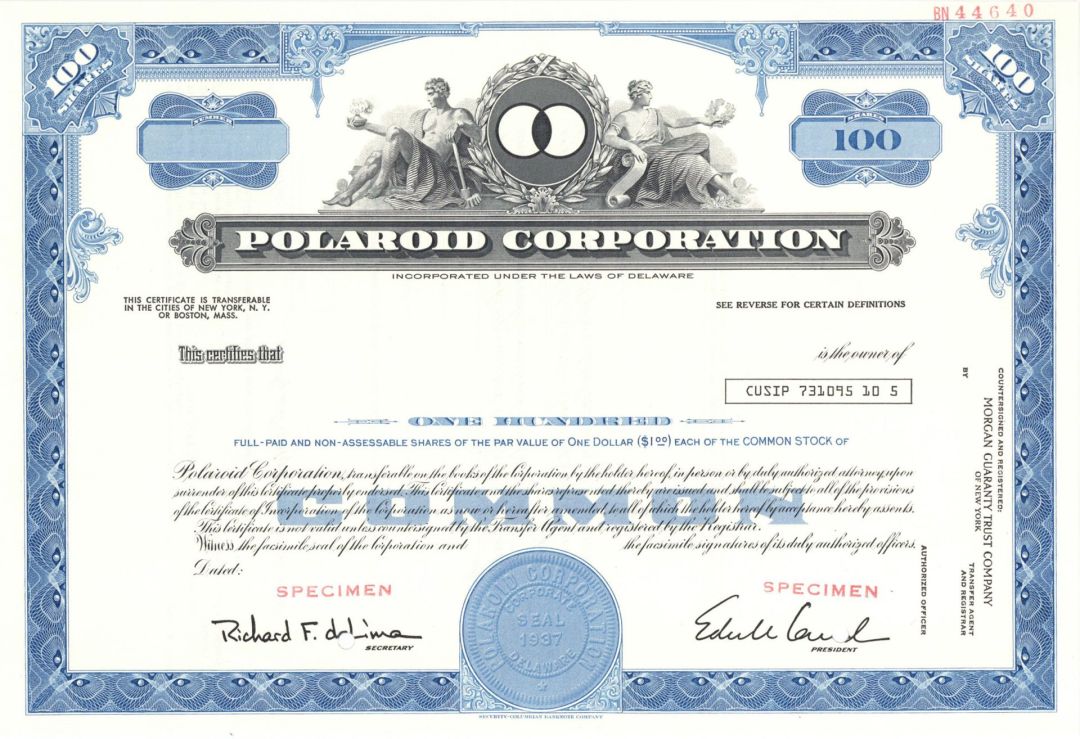Polaroid Corp. - 1937 Specimen Stock Certificate
Inv# SE1565 Specimen StockMassachusetts
New York
Specimen Stock printed by Security-Columbian Banknote Company. Please specify color.
The original incarnation of Polaroid was an American company best known for its instant film and cameras, which now survives as a brand for consumer electronics. The company was founded in 1937 by Edwin H. Land, to exploit the use of his Polaroid polarizing polymer. Land and Polaroid created the first instant camera, the Land Camera, in 1948. Land ran the company until 1981. Its peak employment was 21,000 in 1978, and its peak revenue was $3 billion in 1991. Polaroid Corporation was declared bankrupt in 2001; its brand and assets were sold off. A new Polaroid company formed, and the brand assets changed hands multiple times before being sold to Polish billionaire Wiaczes?aw Smo?okowski [pl] in 2017. This acquisition allowed Impossible Project, which had started producing instant films for older Polaroid cameras in 2008, to rebrand as Polaroid Originals in 2017, and eventually as Polaroid in 2020. Since the original company's downfall, Polaroid-branded products in other fields, such as LCD televisions and DVD players, have been developed and released by various licensees globally.
The original Polaroid Corporation was founded in Cambridge, Massachusetts, by Edwin Land and George W. Wheelwright III in 1937. It has been described by The Boston Globe as a "juggernaut of innovation", and "the Apple of its time" with a "leader in Edwin Land, a scientist who guided the company as the founding CEO for four decades". Polaroidâs initial market was in polarized sunglasses â spawned from Landâs self-guided research in light polarization. Land, having completed his freshman year at Harvard University, left to pursue this market, resulting in Polaroid's birth. Land later returned to Harvard to continue his research. Polaroid, owning patents to its polarizer technology, got its start by employing polarization in products that included 3-D movies and protective goggles for military dogs. During World War II, Polaroid designed and manufactured numerous products for the armed services including an infrared night viewing device. He led the company as CEO for 43 years. He headed the Polaroid Corporation, developing it from a small research and marketing firm into a well-known high-tech company. Kodak was a customer for some of Land's polarizing products. Recognized by most as the father of instant photography, he included all the operations of a darkroom inside the film itself. He gave the first public demonstration of his new Land Camera in February 1947; from then until 1972, the user had to release the film manually, pull a tab, and peel the negative from the finished positive printâthe first version to eliminate these intermediate steps was the SX-70 of 1972, which ejected the print automatically. Land was pictured on the cover of Life magazine in 1972 with the inscription, "A Genius and His Magic Camera". In the 1940s, Polaroid purchased the B B Chemical Company building at 784 Memorial Drive in Cambridge, Massachusetts for its headquarters. The landmark Streamline Moderne style structure would be added to the National Register of Historic Places listings in Cambridge, Massachusetts in 1982. When Kodak announced instant film cameras in 1976, Polaroid announced they were suing them, accusing Kodak of having stolen its patented instant photography process. In the two years that followed the lawsuit, total sales of instant cameras climbed from 7.4 million cameras in 1976 to 10.3 million in 1977 and 14.3 million in 1978. The suit in federal court lasted 10 years. Polaroid asked for $12 billion for infringements of its patents by Kodak. The court ruled in favor of Polaroid and ordered Kodak to cease instant picture production, plus pay Polaroid $909.5 million of the $12 billion it had asked for. Read more at https://en.wikipedia.org/wiki/Polaroid_Corporation
Stock and Bond Specimens are made and usually retained by a printer as a record of the contract with a client, generally with manuscript contract notes such as the quantity printed. Specimens are sometimes produced for use by the printing company's sales team as examples of the firms products. These are usually marked "Specimen" and have no serial numbers.










Ebay ID: labarre_galleries